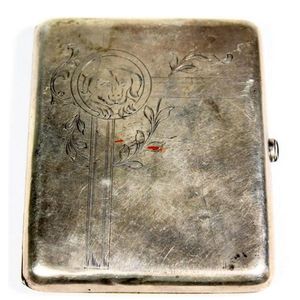George III Sterling Silver Salts and Spoons Set
A pair of George III sterling silver salts London, 1791 by John Wakelin and William Taylor. Oval, gilded interiors with dividers, gadroon borders. Together with four salt spoons, London, 1802.
You must be a subscriber, and be logged in to view price and dealer details.
Subscribe Now to view actual auction price for this item
When you subscribe, you have the option of setting the currency in which to display prices to $Au, $US, $NZ or Stg.
This item has been sold, and the description, image and price are for reference purposes only.
- Gilding - Gilding is a method of ornamentation whereby a thin sheet of gold metal is applied to items made of wood, leather, ceramics, glass and silver for decorative purposes.
For furniture including mirrors, the sheet of gold is usually applied over a coating of gesso. Gesso is a mixture of plaster of Paris and gypsum mixed with water and then applied to the carved wooden frames of mirrors and picture frames as a base for applying the gold leaf. After numerous coats of gesso have been applied, allowed to dry and then sanded a coat of "bole", a usually red coloured mixture of clay and glue is brushed on and allowed to dry, after which the gold leaf is applied. Over time parts of the gilding will rub off so the base colour can be seen. In water gilding, this was generally a blue colour, while in oil gilding, the under layer was often yellow. In Victorian times, gilders frequently used red as a pigment beneath the gold leaf.
Metal was often gilded by a process known as fire gilding. Gold mixed with mercury was applied and heated, causing the mercury to evaporate, the long-term effect of which was to kill or disable the craftsman or woman from mercury poisoning. The pursuit of beauty has claimed many victims, not the least of which were the artists who made those pieces so highly sought after today. - George Iii - George III (1738 - 1820) was King of Great Britain and Ireland from 1760 to 1820.
- Sterling Silver - Sterling silver is a mixture of 92.5% pure silver and 7.5% of another metal, usually copper. Fine silver is 99.9% pure silver, and is relatively soft and the addition of the very small amount of copper gives the metal enough strength and hardness to be worked into jewellery, decorative and household objects.
Visually similar items

Shield, Central Australia (1960s), natural earth pigments on carved beanwood. 62.5 cm
Sold by
in
for
You can display prices in $Au, $US, $NZ or Stg.

A Russian silver (875) cigarette case, post 1958, Wt 134 g
Sold by
in
for
You can display prices in $Au, $US, $NZ or Stg.

A vintage brass glass-top side table
Sold by
in
for
You can display prices in $Au, $US, $NZ or Stg.

18ct emerald and 24 stone diamond ring four claw set, oval mixed cut emerald 1.0ct approx. With 24 round modern brilliant cuts approx. TDW 0.36cts
Sold by
in
for
You can display prices in $Au, $US, $NZ or Stg.
